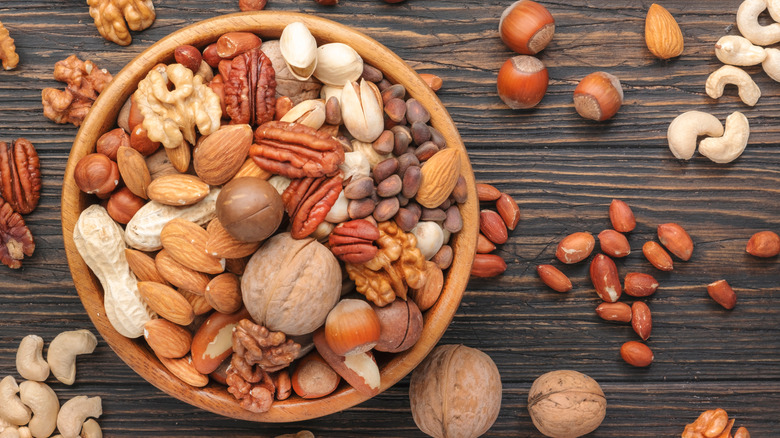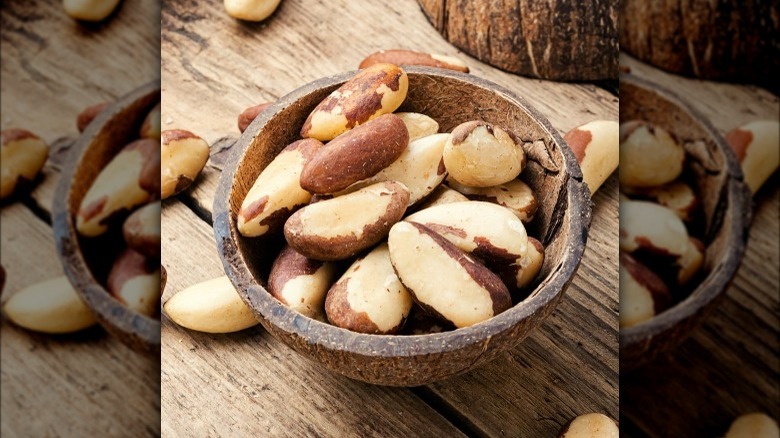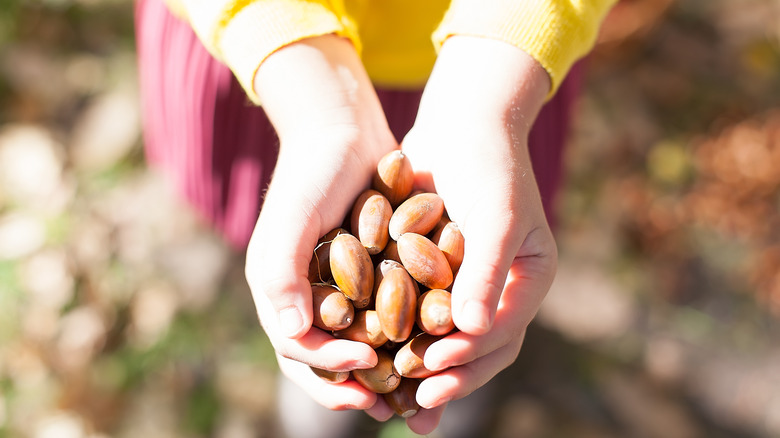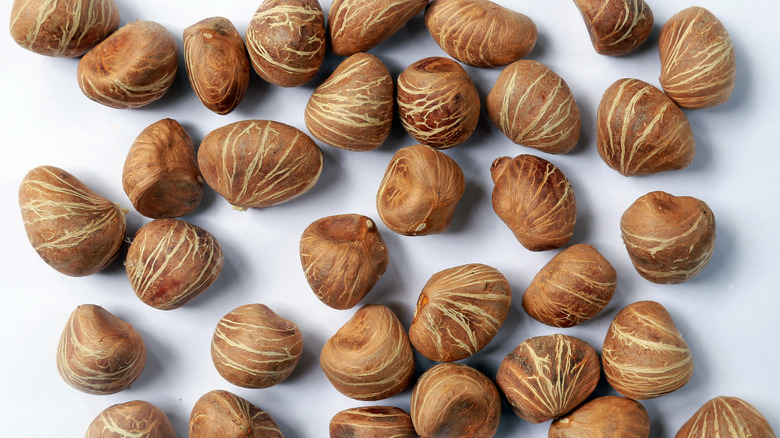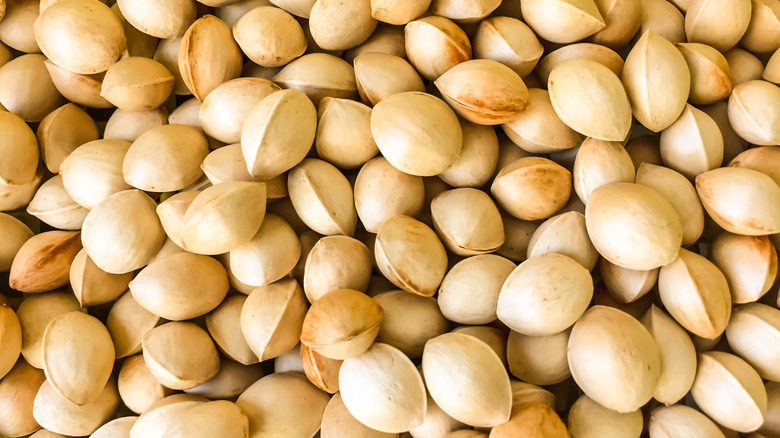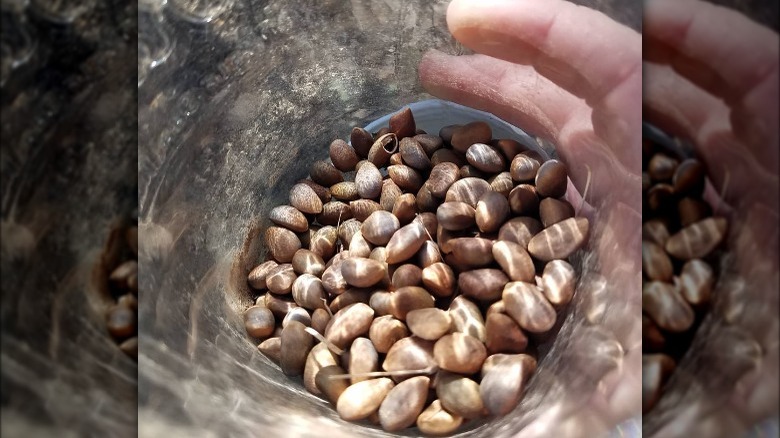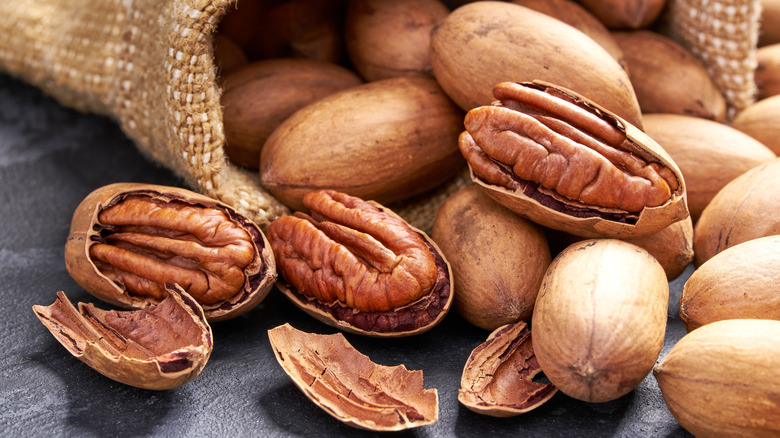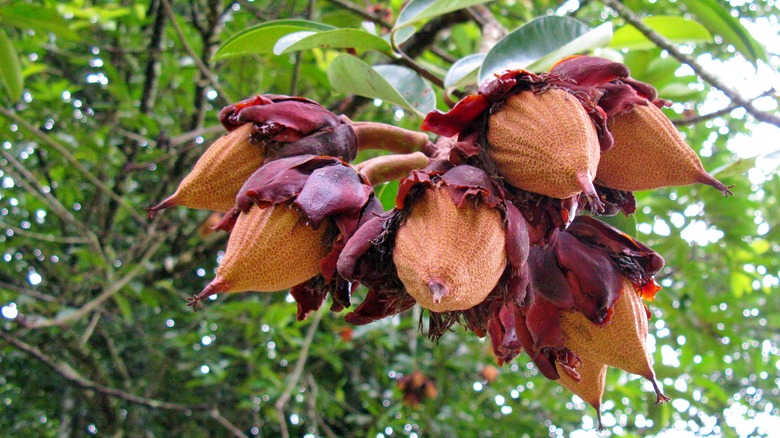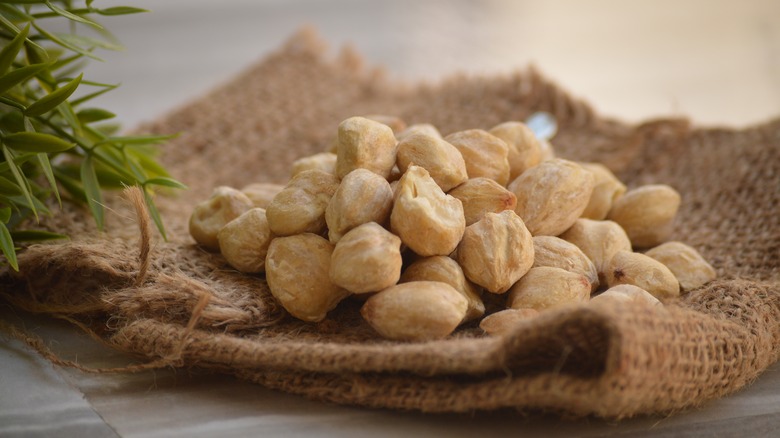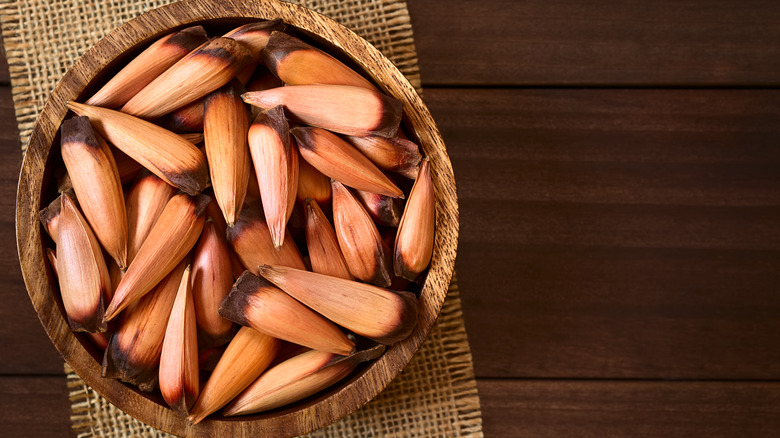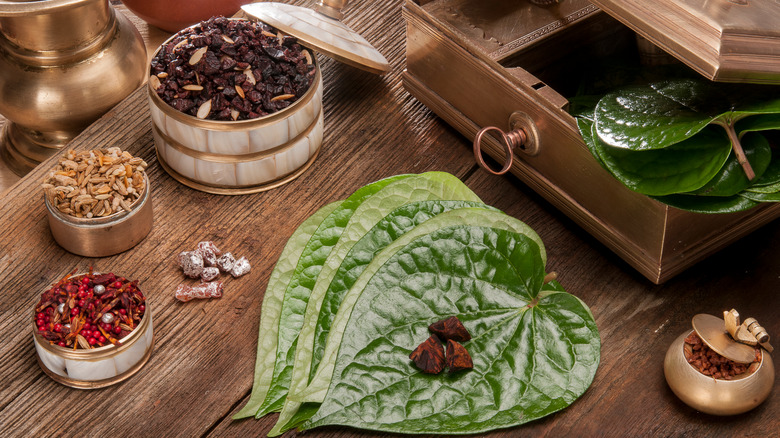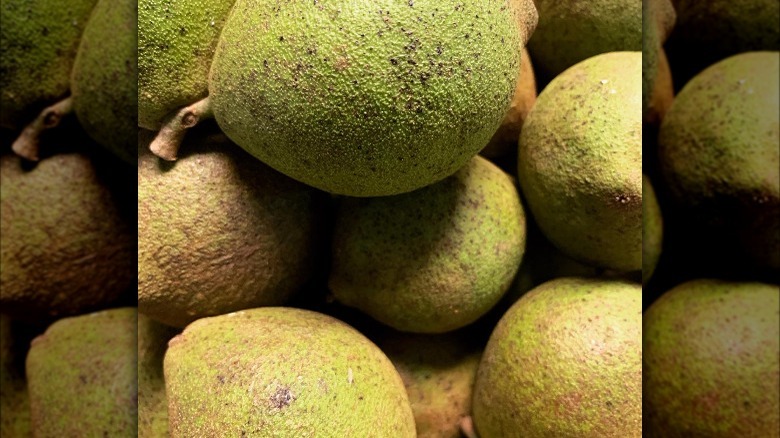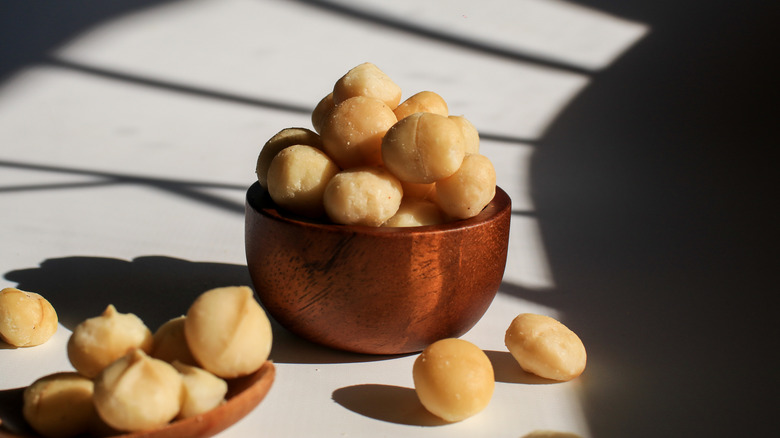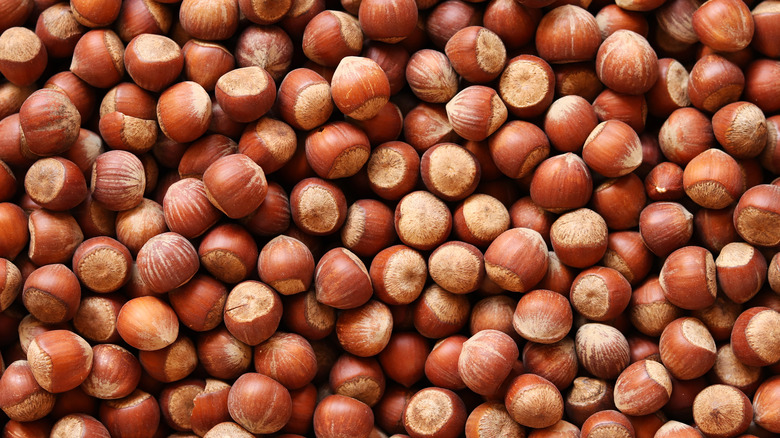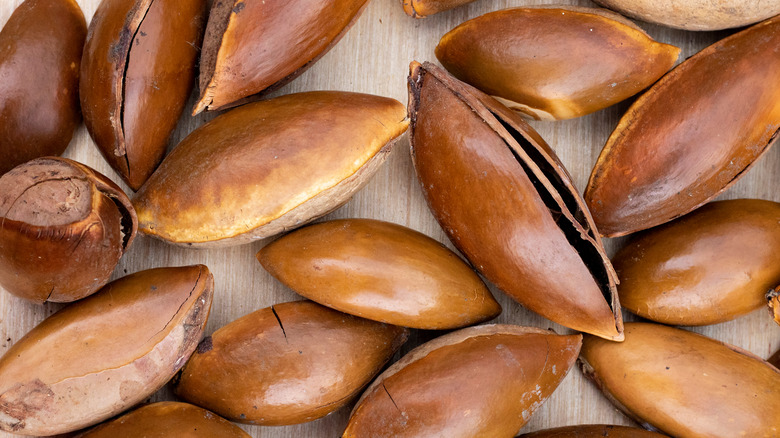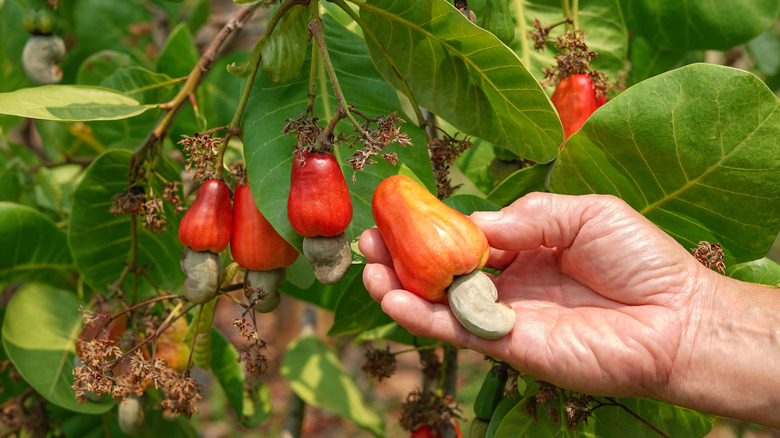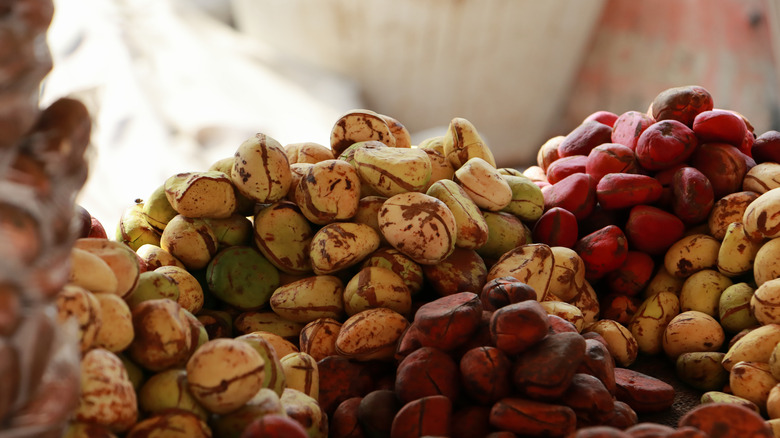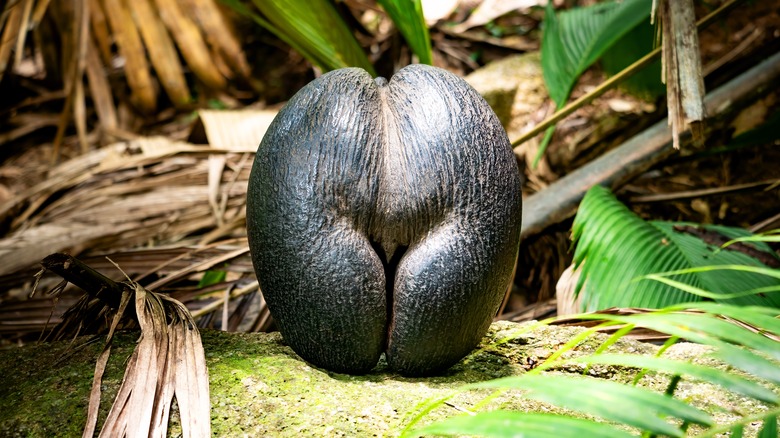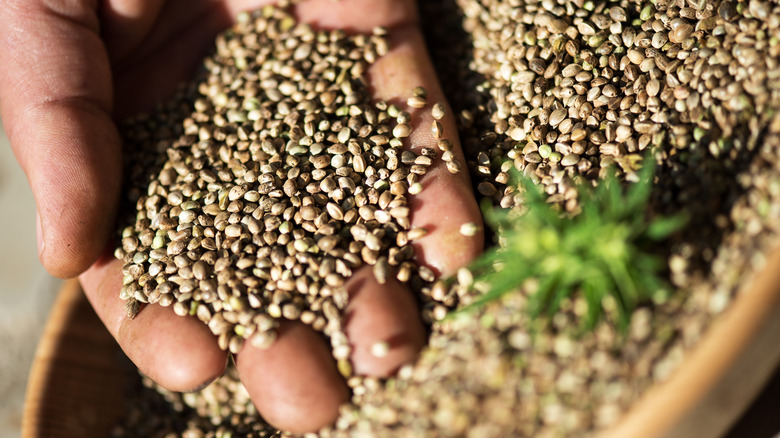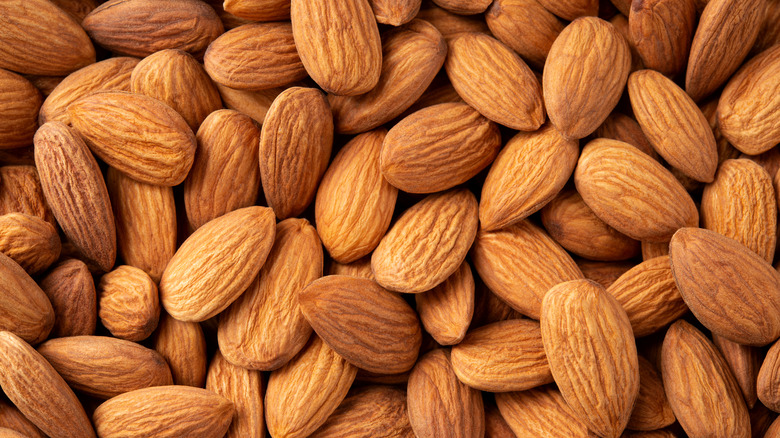20 Types Of Nuts And What Makes Them Unique
Aw, nuts! Or maybe, aw yeah nuts! Nuts are no stranger to us nowadays. In fact, they're probably something that humans have been eating since we've been on this planet (via How Stuff Works). Whether it's the sweet smell of chestnuts roasting on that famous open fire, summer pecan pies, or a handful of almonds following a workout, just about everyone knows how healthy and flavorful nuts can be. But, sometimes the banalest still carry surprises.
Even just trying to define nuts is a more complex undertaking than one might imagine. Sure, the botanical definition of the nut is quite clear: a dry fruit with a single seed, hard outer shell, and dry husk (via the U.S. Forest Service). Those classic chestnuts mentioned above, for example, fit the botanical definition of a nut to a T. But, in the vast and wonderful culinary world, things get a little dicier. The Spruce Eats argues that nuts exist as a fruit, seed, or legume. What truly characterizes the nut is rather its tender flesh and hard outer shell. Pretty nutty, right?
With such a broad definition, there's a whole world of nuts out there that range from the supremely healthy to the supremely tasty and everything in between. Without further ado, here are 20 nuts that are worth taking a closer look at.
1. Brazil nuts
Brazil nuts are mighty and contain multitudes. On the one hand, they are brimming with the ever-rare selenium, a trace mineral that helps make DNA and prevent infection (via WebMD). This nut has long been enjoyed in the Amazon where it originates, and today can be found supplementing vegetarian, vegan, and keto diets with the much-needed trace mineral. This nut is, simply put, a powerhouse. But, there is an interesting, if not bizarre, catch: Brazil nuts contain another rare ingredient known as radium (via Museum of Radiation and Radioactivity). It's not every day that one has to confront the question: What does it mean to eat radioactive food? Is it safe?
There is no need to fear as the German Federal Office for Radiation Protection (Bundesamt für Strahlenschutz) assures that while Brazil nuts do exceed the normal amount of radiation in food by an insane 1,000%, there's still no risk of radiation poisoning or symptoms of radiation. The agency does note that despite this, one should really only eat a maximum of two Brazil nuts per day. Ever practical the Germans, the report also notes that there are plenty of foods with selenium that do not contain high amounts of radium. For those willing to take the plunge, Brazil nuts are smooth and buttery with a rich flavor that characterizes most nuts (via NDTV Food). While most probably use the Brazil nut as some sort of supplement, the nut works well in smoothies, bread, and nut butters.
2. Acorns
A friend that marks the fall of Fall, though unforeseeably it was forgotten that acorns function as foodstuffs. Alliteration aside, it's true! Acorns are edible. Before taking to the forest and shoveling handfuls of acorns into your mouth like some sort of squirrel, do take heed that raw acorns are not edible. When left uncooked, acorns contain the toxic element tannin, whose bitter taste can be harmful to humans, cattle, horses, and dogs when consumed in large quantities (via Woodland Trust). So, what's the point then? Thankfully, it's quite easy to make acorns safe to eat. The simplest means is leaching the tannin out of acorns by washing them in hot or cold water. WebMD suggests soaking or boiling the acorn harvest until the water browns. The health website advises replacing the browned water with fresh water and repeating until the water stays clear.
Once safe to eat, the going gets good. Woodland Trust observes that roasting tends to best bring out the nut's natural flavor while adding a smokier finish; a winter stew with an acorn twist is also a wonderful addition to chilly nights. Their most daring suggestion might just be acorn coffee. Though caffeine-free, acorn coffee slightly mimics coffee's complex roasted taste, all the while looking like a traditional cup of Joe. Those roasting their own acorns even have the choice of bolder dark roasts or lighter blonde roasts — the real trick is figuring out what works for you!
3. Malabar chestnut
The Malabar chestnut may come off as exotic, but these nuts are actually the work of none other than the money tree. Though money trees are gifted as tiny trees to warm a house or business, in the right outdoor growing conditions, they can reach up to 60 feet in height. Maybe Kendrick wasn't so off in saying that money trees are the perfect place for shade. Though usually linked with Asia, according to the California Rare Fruit Growers Association, the nut actually has roots much closer to home, as it originally grew in locations from Mexico to Guyana. Here the name mystery might be solved, as the Malabar chestnut is also known as the Guyana chestnut. Guyana has such close ethno-cultural ties with India that perhaps the Malabar coast served as inspiration for the nut. Etymology aside, there's a lot to do with Malabar in the kitchen.
Specialty Produce likens the taste of the raw Malabar chestnut to that of peanuts. It's only once they're cooked that they begin to take on that unmistakable chestnut taste, with lingering notes of macadamia. Roasting Malabar chestnuts also adds a nice crunchy texture to the otherwise soft nut. A wonderful snack in their own right, Malabar chestnuts also tend to work well with savory dishes and can add elegant and rich notes to any stir-fry.
4. Gingko nuts
So varied that it's poisonous when raw and an aphrodisiac when roasted, the gingko nut has range. As GQ points out, some might be coming to gingko nuts with a bad taste in their mouth, or rather a bad smell in their nose — gingko trees bear fruit that reeks of old cheese. The gingko fruit's flesh isn't any more inviting as it can cause an allergic reaction — even those without sensitive skin are advised to wear gloves while foraging.
Stink, rashes, and toxins — there's certainly a lot working against the gingko nut. GQ believes that the risk is worth taking, not because of the nut's alleged health benefits, but rather its unique flavor. The journalist describes the gingko nut as controlling major umami, like an elevated artisanal popcorn with a one-of-a-kind gummy texture.
Which isn't to say rush in head first! The Hong Kong Center for Food Safety notes that raw gingko nuts are exceptionally poisonous. In fact, the younger the nut, the more toxic it is. However, cooking will help reduce, but not inactivate, toxins. The center recommends limiting gingko intake to a few seeds per day. Any more than this and you might suffer from gingko poisoning, which can manifest as nausea, vomiting, and convulsions, among other symptoms. It is worth noting that the gingko nut has been a well-loved garnish in Southeast Asian desserts, like congee, for a long time.
5. Mexican piñon nut
The Mexican piñon nut is a hyper-regional nut that can be found in northern Mexico and primarily the U.S. southwest, especially New Mexico (via Gardening Know How). The nut has a long history in the otherwise arid region — it supplemented indigenous cuisine and most likely sustained colonizers pushing west. Outside of sheer survival, piñon nuts surely are a welcome addition to whatever dish they're added to. Though the name piñon translates directly to pine nut, the nut is, confusingly, a completely different variety altogether. New Mexico Magazine asserts that piñon nuts do have a pine-like taste, but also are a lot gamier compared to other pine and pine-like nuts.
Piñon nuts are so ubiquitous in local cuisine that New Mexico has even made the piñon tree its state tree. It makes sense to take culinary cues from them, and boy howdy, are there a lot. Gardening Know How notes that the piñon nut does exceptionally well when ground into a savory filling. The justly named New Mexico empanadas make for a welcome festive treat, and the Just a Pinch food blog offers an especially mouthwatering Christmas recipe. New Mexico Magazine suggests a chocolate piñon torte for those craving something sweeter.
6. Pecans
A true Southern belle, the pecan knows no bounds. This is another nut that is actually native to the Americas and is, maybe befittingly, the fattiest of all nuts (via BBC Good Food). It's this high level of fat that gives it its distinct and rich flavor. For those who haven't had the pleasure of eating a pecan, its flavor can be best described as buttery and sweet, though the outer shell is slightly bitter when raw, as described by The Spruce Eats. The food site describes the pecan's unsweetened flavor as candy-like. Despite its sweet leanings, the pecan still has its savory moments and plays well with savory seasonings. The food blog, Evolving Table, suggests roasting pecans with a truly scrumptious medley of maple syrup, butter, and Cajun seasoning to give a New Orleans twist to a classic Southern delight.
Given the pecan's prowess in the dessert arena, it might be easy to forget that the pecan on its own has many amazing health benefits. As described by the University of Wyoming, raw pecans are still completely edible and even a great source of protein, calcium, and magnesium. A pecan can even find home peeled in an autumnal salad. Like any Southern lady, the pecan makes for sweet company.
7. Dika nuts
Also known as African mango, dika nuts at one point took diet culture by storm. Even today, African mango extract, made from the extract of dika nuts, can be found in many diet pills and elixirs. While McGill's Office of Science and Study cautiously asserted that even though African mango has been linked with appetite repression in one study, there still needs to be more research to understand the nut's full effects. WebMD takes a harder stance and asserts that there's no cure-all for magically losing weight.
They may not aid in weight loss, but dika nuts have a lot to offer. Despite the nut's rather controversial strut onto the world stage, Lost Crops of Africa asserts that African mangoes have long had a meaningful presence in the West African diet. Dika nuts are often harvested separately and used to make a broad range of foodstuffs, such as dika nut butter and a compacted chocolate-esque bar. More often than not, dika nuts are ground into seasoning or used as the base for the traditional ogbono soup. The oiliness of the dika nut can't be ignored — the nut is about 50% oil, which makes for great cooking oil or even potentially an environmentally friendly lubricant. The food-oriented think tank, Foodtank, believes that dika nuts are on the verge of being domesticated. With so many possibilities, perhaps it's time for dika nuts to join the international market.
8. Candlenut
A gorgeous name if there ever was one, the candlenut has long held favor in Southeast Asian and Oceanic cuisine where it has traditionally been used as a thickening agent (via Epicentre Herbs and Spices). According to the site, candlenuts first got their start in Australia, Malaysia, and the Moluccas Islands, where they were roasted and used as a filling and nutritious food source. Once candlenuts made it over to Hawai'i, they came to symbolize enlightenment, peace, and protection.
The etymology of the candlenut name is pretty straightforward. Candlenuts have an absurdly high oil content, so high and fatty that they were once used to make candle and lamp oil. They were effectively dual energy sources for humans for a long time. There's a lot of tradition to these macadamia-sized treats. That being said, candlenuts are very similar to macadamia nuts in look and taste as well. Though, do note that candlenuts are slightly gritty in texture and need to be roasted to be both non-toxic and flavorful.
Though candlenuts can make for a wonderful thickened soup, those craving a more direct interaction should look into Indonesia's gadogado, or mixed salad. However, this is hardly a salad but rather a symphony of fresh vegetables, garlic, protein, lime leaves, grain, and roasted candlenut, all drizzled with a homemade peanut dressing.
9. Monkey puzzle nut
A puzzling name, the intrigue only begins with the name monkey-puzzle. Monkey puzzles earned their name from a botanist's observation that even monkeys would find it difficult to navigate the oddly-shaped and placed branches of this evergreen (via Woodland Trust). The pine tree has roots in both Chile and Argentina, where its piñones (sound familiar?) long played an important role in local cuisine, as noted by Global Trees. The monkey puzzle tree has since captured the hearts of North Americans and even those on the British Island, the latter of which have made a home for a startling amount of monkey puzzle trees today.
The Experimental Farm Network praises the monkey puzzle tree for being sustainable, as the trees take a whopping 30 to 40 decades to produce fruit and encourage slow reduced-carbon farming. Once the nuts are ready to harvest, it's almost immediately clear that monkey puzzle nuts taste much more similar to chestnuts than pine nuts when eaten raw, though they resemble the latter quite closely. Monkey puzzle nuts can be processed into a rich edible oil or dressing, which can commonly be found in Chile (via Veggies Info). But if looking for a simple touch, raw monkey puzzle nuts can work as a lovely and rich garnish.
10. Betel nut
Used in Indian desserts and as an appetizer, but primarily as a mild stimulant, betel is a classic. For those unfamiliar, the betel nut is a tiny black nut that more closely resembles a seed and has a distinct nutmeg-like taste (via Specialty Produce). In a profile with Vice, one journalist argues that there's a lot of bad hype surrounding the nut. He argues that it's used more with the intention of getting a slight buzz, perhaps akin to coffee. He is quick to point out that in India, betel verges on snack territory, and is sometimes served on a betel leaf mixed with spices and a sweet paste. Betel is often used as a breath freshener as well.
This is all well and good but slightly undercut by one of the interviewees noting that betel is so intense when served in India or Pakistan that some throw up after trying it for the first time. This, of course, doesn't sound so innocuous. BBC takes a more drastic stance and observes a "betel scourge" in Asia. It contradicts the Vice article and notes that betel nuts can contain as much caffeine as six cups of coffee. The article, along with Vice, notes the mind-altering aspects of the nut along with the physical: stunningly red-stained teeth. It makes the case that betel nut addicts have higher rates of oral cancer and warns of the addictive properties of the betel nut. Simply put, do beware!
11. Pistachios
Pistachios have been in the U.S. for a while, though not for too long. It's been speculated that the pistachio seed first arrived within the 19th century (via Khosbin Group). However, according to Refinery29, it was really the 21st century that saw the rise of the pistachio through clever marketing. The pistachio has endured as a tantalizing snack ripe for the picking or, rather, peeling. Livestrong really gives pistachios their laurels and points to the iconic pistachio-green color as an indicator of the unique blend of amino acids that the bite-sized nut has to offer. What's more is that the pistachio has been known to protect the brain, regulate sugar, aid in digestion, and promote heart health. Now, that's a mouthful.
It seems like there's more on the horizon for the already beloved nut. While 2021 saw the return of pistachio green in fashion, it also saw another rise to the already Olympus-like structure that pistachio occupies in the food world. In an era of accepted lactose intolerance and a push toward plant-based alternatives, among a chopping board of other reasons, it seems that the pistachio might just be the Beyoncé of the nut world — it has since made its way to plant-based milk. The Beet describes pistachio milk as superior, rich in flavor, complex, creamy, and, for café-aficionados most importantly, frothy.
12. Black walnuts
While English walnuts might be more common on the market, black walnuts are also edible and can add extra oomph to any dish (via Knowledge Nuts). It's not just the color that differentiates these two nuts. While the English walnut actually originates from the Fertile Crescent, the black walnut, also known as the California black walnut, is native to North America (via Serious Eats). While sources agree that English walnuts have a somewhat mild, broad taste, black walnuts are truly their own: bold and earthy in flavor. One only needs to see a black walnut husk to see how bold this nut is; its thick husk is bright green to yellow in color and leaves a palpable scent on the hands. So intense is the coloring of this nut, that its shell is likely to leave hands blackened.
Black walnuts clearly hold their own. Once cracked, there isn't anything that needs to be done to bring out their naturally potent flavor. However, black walnuts tend to add an edge to otherwise uniform flavors. Black walnut molasses and black walnut honey can add a twist to old-school favorites at the Sunday morning breakfast table.
13. Macadamia nuts
The U.S., specifically Hawai'i, remains one of the largest producers of macadamia nuts, which have earned the illustrious title of "World's Most Expensive Nut," coming in at a hefty $25 per pound (via Business Insider). The magazine attributes this exceptional price tag to the fact that macadamia nuts can only be produced by two out of the 10 macadamia tree varieties. Further adding to the bill, the nuts need to be harvested slowly, by hand. The thick shell of the macadamia nut makes it hard for machines to differentiate between ripe and unripe, so for the time being, hard manual labor is the only way to harvest this sweet nut. When looking at it from this perspective, it's any wonder that macadamia nuts are as available as they are nowadays.
Even without these justifications, the price tag promises an incredibly creamy nut with wonderful texture and a shockingly sweet flavor. Many of us know the white macadamia nut cookie that tends to work as a sweeter companion to the chocolate chip cookie during the holidays. But, as Lifestyle Asia points out, the macadamia really does shine wherever it goes, whether as a gourmet oil, salad dressing, garnish, or even all on its lonesome with all the good it can bring to a daily diet.
14. Hazelnuts
Also known as filberts, hazelnuts offer a sweet flavor that pairs exceptionally well with many other flavors. But maybe the real perfect pair for hazelnut is chocolate, as evidenced by the Italian gem Nutella. While hazelnut trees are well suited to sustainable agriculture, there are a few environmental concerns surrounding the treat. For one, there are problems with mass hazelnut farming, especially in European countries, like Italy, that rely on exporting it. Hazelnut monoculture not only threatens soil, air, and water quality but also riddles local ecosystems with a copious amount of pesticides (via Deutsche Welle). As noted in the article, pesticide use usually spells long-term damage to surrounding areas, especially fragile wetlands.
But there's a way to enjoy hazelnuts and their by-products a bit more conscientiously. For one, hazelnut production isn't limited to overseas; in fact, it can be extremely local. Oregon, specifically, is the largest producer of hazelnuts in the United States — Willamette County even produces a shocking 99% of the country's hazelnuts (via Arbor Day Foundation). Sourcing from American hazelnuts can not only assure a smaller carbon footprint but larger control over the farming practices surrounding the nut. Not to mention, homemade Nutella is healthier and better adjusted to personal taste while also weighing lighter on the wallet. Hazelnuts can also be transformed into many other gorgeous food moments, like as one Delishably article notes, a creamy parsnip soup with hazelnuts.
15. Maya nut
One nut, many names: ramon, breadnut, ojite, ojushte, ujushte, and capomo. More often than not, it is known as none other than the Maya nut, which refers to its origins in the tropical rainforests of Latin America and the Caribbean as well as its long-held importance in indigenous cuisine (via Maya Nut Institute). It is estimated that this nut has been eaten for around 2,000 years, as per Sustainable Gardening Australia. The name, breadnut, may come from the fact that many communities have long made ground Maya nuts into a paste and baked this paste into a tortilla (via Blue Zones).
Nowadays, the nut remains just as relevant and versatile. Blue Zones classifies the Maya nut as a potential superfood due to its dense concentration of nutrients, vitamins, and minerals. But, there's an interesting secondary use for Maya nut: it also serves as a coffee substitute. The caffeine-free Maya nut brew could be good for those looking to ween off of or limit caffeine.
According to some climate models, the Maya nut may be well adapted to the projected climate change trajectory and could even work as a natural CO2 trap that could potentially help lower temperatures, if only slightly. It could very well be one of the "winners" of the new climate and provide a safeguard of nutrition in a changing world.
16. Cashews
Another nut that is native to the Amazons, the cashew might ring more of a bell. Growing from bright red and orange fruit, cashews are healthful nuts that have many culinary and dietary uses. Similar to macadamia nuts, cashew nuts are very buttery and creamy. Taste of Home notes that this creamy taste comes with a high level of healthy fats, antioxidants, and, of course, protein. The site does note that because these are such heavy-hitters, moderation is always key. One important thing to note is that, similar to other nuts on this list, raw cashews are unsafe to eat and slightly toxic. Cashews should only ever be enjoyed roasted.
Cashew milk is a wonderful milk alternative that has an earthier flavor in comparison to other plant-based milks, and one that also contains quite a lot of protein. Compared to other plant-based milks, cashew milk has a relatively low carbon footprint (via Footprint Network). But to save costs, or even to have fresh plant milk, it's relatively straightforward to make cashew milk at home, especially using guides like the one offered by Tasty Yummies.
17. Kola nuts
The taste of cola can trace its way back to the kola nut (via Healthline). The kola nut is a natural flavoring that gave Coca-cola and Pepsi-cola their signature flavor. While it is no longer included in the ingredient list nowadays, it originally served to bring these drinks to the market. One would expect kola nuts to have an intensely sweet flavor, but kola nut flavor is better described as bitter and increasingly sweet when chewed on (via Tastylicious).
Those expecting the equivalent of a bottle of Coke from a tree will be sorely disappointed. What they won't be missing, however, is that high that's often associated with drinking a highly caffeinated beverage. As Healthline notes, kola nuts act as a natural central nervous system stimulant, albeit mild. Kola nuts find a home in the African rainforests, though they are widely eaten throughout Africa as a whole nut. Besides being eaten raw, kola nut powder can be used for soft drinks and also as a meat rub. Kola nuts themselves can be boiled into a highly caffeinated and slightly bitter tea. Though common in Africa, in the U.S., kola nuts are more often found in the form of extracts, even though they are completely cleared by the FDA (via Greatist).
18. Coco de mer
The name coco de mer, or coconut of the sea, isn't symbolic but rather descriptive. These nuts were often found floating out in the Indian Ocean and were once thought to be the product of underwater trees (via Amusing Planet). According to Nature World News, the coco de mer is the largest nut in the world — its seed alone weighs in at 35 pounds.
This nut is also uniquely shaped. Its large blue-black mass is, as diplomatically described by The Guardian, suggestive. Maybe this is why the coco de mer nut sells as an aphrodisiac in Asia. The coco de mer nut also has a slightly earthy flavor, and one culinary festival sought to pair it with a carousel of creamy confections like ice cream and mousse (via Gastro Obscura).
Those hankering for coco de mer will be sorely remiss as the plant is currently endangered, partially due to coco de mer poaching and overuse of the nut in general. This is aggravated by the fact that coco de mer trees take multiple decades to begin producing fruit, which in turn take up to 10 years to ripen, as noted by the California Academy of Sciences. There are currently conservation efforts taking place on the coco de mer's home island of Seychelles, many of which look to empower locals to grow and conserve the trees themselves. Hopefully, these efforts succeed and this unforgettable plant won't be a thing of the past.
19. Hemp nuts
Hemp is a plant that needs no introduction, but the details behind this nut may surprise you. Hemp, unlike its cousin marijuana, doesn't contain any psychoactive ingredients and won't provide a psychological high, as Bon Appétit points out. The culinary magazine describes hemp seeds as an all-around hit, which are kernel-sized seeds with a soft green interior, also known as hemp hearts. Hemp seeds, but especially their hearts, are rich in a plethora of beneficial nutrients and amino acids. Now, by now, one may be asking, hemp seeds? On a nut list? What sort of shoddy writing is this? Like a few others on the list, while technically a seed, hemp seeds actually function culinarily as a nut (via WebMD).
For those with nut allergies who do not wish to drink milk, hemp milk provides a palatable and hypoallergenic milk alternative. Hemp seeds truly do provide an alternative for many. For those that are gluten intolerant, hemp seeds can function similarly to bread crumbs in the kitchen — either on fish or chicken or topping casseroles. In general, the crunchy yet naturally small texture of hemp seeds lends itself well to more unexpected dishes; whether on top of oats, ice cream, or açaí, the hemp seed finds itself at home.
20. Almonds
Almonds have long entertained a place in the American cuisine and heart. Restaurant Business Online describes almonds as having a smashing success in the restaurant industry and as a darling of the health food market. Of course, this isn't without reason, as it's been made clear that almonds offer a plethora of nutrients, acids, and protein (via BBC Good Food). This passionate embrace with almonds isn't unique to the U.S. — worldwide, it is the second best-selling nut next to peanuts (via Irish Times). But, like a Gemini, there are two sides to these nuts.
One of the largest complaints lobbed against almonds is their water footprint, as noted by the NPR. Almond plants need a lot of water and, for the current market, they're grown as a year-round crop. California, an already drought-leaning state, is the largest producer of the States' almond supply, which stickies an already sticky environmental situation.
What's more is that bees are specifically threatened by almond farming (via The Guardian). Farms will import and migrate bees to pollinate almond trees. The heavy use of pesticides, however, kills the bees without giving them a chance to repopulate, as noted by both The Guardian and The Irish Times. This is not only cruel but extremely callous considering that bees are both important pollinators and endangered. With the current climate crisis in mind, these problems are not only not justifiable, they are unignorable. While there aren't major streamlined sustainable means of producing almonds today, perhaps there are better things awaiting tomorrow.
